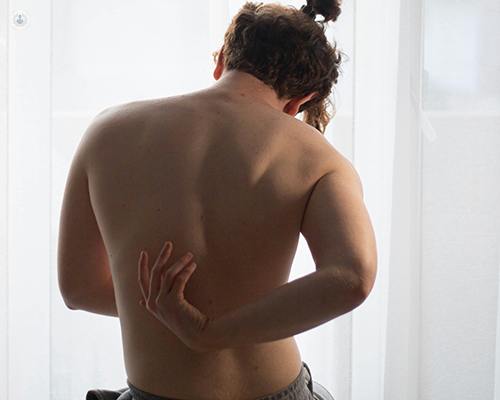What are the most common causes of sciatica, and how is it treated?
Autore:Sciatica is a condition characterised by pain that radiates along the path of the sciatic nerve, which branches from the lower back through the hips and buttocks and down each leg. This condition commonly affects only one side of the body. The intensity and type of pain can vary, often described as sharp, burning, or similar to an electric shock. In his latest online article, Dr Mohammed Qureshi gives us his insights.

Causes of sciatica
Sciatica is most commonly caused by a herniated disk in the spine, bone spurs on the vertebrae, or narrowing of the spine (spinal stenosis) compressing part of the nerve. This pressure on the nerve can cause inflammation, pain, and often some numbness in the affected leg.
Several risk factors can increase the likelihood of developing sciatica. Typical age-related alterations in the spine, like herniated discs and the formation of bone spurs, frequently contribute to the condition. Obesity can also increase spinal stress, contributing to spinal changes that trigger sciatica. A sedentary lifestyle or jobs that require prolonged sitting can also contribute to the development of the condition.
Symptoms of sciatica
The hallmark symptom of sciatica is pain that radiates from the lower (lumbar) spine to your buttock and down the back of your leg. The pain can vary widely, from a mild ache to a sharp, burning sensation or excruciating pain. Sometimes, it can feel like a jolt or electric shock.
Symptoms may exacerbate during coughing or sneezing, and prolonged periods of sitting can worsen the condition. Generally, only one side of your body is affected.
Other common symptoms include numbness, tingling, or muscle weakness in the affected leg or foot. Some people might experience a "pins and needles" sensation, a common indicator of nerve involvement.
Diagnosing sciatica
The diagnostic process commences with a comprehensive review of medical history and a physical examination. During the physical exam, doctors may check muscle strength and reflexes. Imaging tests, such as X-rays, MRI, or CT scans, can help pinpoint the causes by revealing detailed images of your spine and identify conditions affecting the sciatic nerve.
Treatment options
Treatment for sciatica depends on the severity of the condition. Initial treatments typically involve self-care measures such as applying hot or cold packs, over-the-counter pain relievers, and physical therapy.
Physical therapy can be particularly beneficial as it helps strengthen the muscles supporting your back, improves your posture, and increases your flexibility.
For more severe cases, other treatments might include prescription medications, steroid injections to reduce inflammation around the nerve roots, or even surgery, particularly if there is significant muscle weakness, loss of bowel or bladder control, or if the pain worsens progressively.
Prevention
Preventing sciatica involves addressing some of the common risk factors. Regular exercise, particularly exercises that strengthen the core muscles and improve flexibility, can help prevent back injuries.
Maintaining good posture while sitting and standing, and using proper techniques for lifting heavy objects are also essential preventive measures.
Dr Mohammed Qureshi is an esteemed pain management specialist. You can schedule an appointment with Dr Qureshi on his Top Doctors profile.


